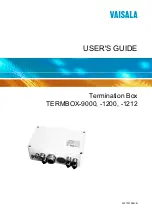
Chapter 5
| SNMP Commands
SNMPv3 Commands
– 145 –
SNMPv3 Commands
snmp-server
engine-id
This command configures an identification string for the SNMPv3 engine. Use the
no
form to restore the default.
Syntax
snmp-server engine-id
{
local
|
remote
{
ip-address
}}
engineid-string
no snmp-server engine-id
{
local
|
remote
{
ip-address
}}
local
- Specifies the SNMP engine on this switch.
remote
- Specifies an SNMP engine on a remote device.
ip-address
- The Internet address of the remote device.
engineid-string
- String identifying the engine ID. (Range: 9-64 hexadecimal
characters)
Default Setting
A unique engine ID is automatically generated by the switch based on its MAC
address.
Command Mode
Global Configuration
Command Usage
◆
An SNMP engine is an independent SNMP agent that resides either on this
switch or on a remote device. This engine protects against message replay,
delay, and redirection. The engine ID is also used in combination with user
passwords to generate the security keys for authenticating and encrypting
SNMPv3 packets.
◆
A remote engine ID is required when using SNMPv3 informs. (See the
snmp-
server host
command.) The remote engine ID is used to compute the security
digest for authentication and encryption of packets passed between the switch
and a user on the remote host. SNMP passwords are localized using the engine
ID of the authoritative agent. For informs, the authoritative SNMP agent is the
remote agent. You therefore need to configure the remote agent’s SNMP
engine ID before you can send proxy requests or informs to it.
◆
Trailing zeroes need not be entered to uniquely specify a engine ID. In other
words, the value “0123456789” is equivalent to “0123456789” followed by 16
zeroes for a local engine ID.
◆
A local engine ID is automatically generated that is unique to the switch. This is
referred to as the default engine ID. If the local engine ID is deleted or changed,
all SNMP users will be cleared. You will need to reconfigure all existing users
(
page 147
).
Summary of Contents for EX-3524
Page 2: ......
Page 28: ...Figures 28 ...
Page 34: ...Section I Getting Started 34 ...
Page 58: ...Chapter 1 Initial Switch Configuration Setting the System Clock 58 ...
Page 72: ...Chapter 2 Using the Command Line Interface CLI Command Groups 72 ...
Page 156: ...Chapter 5 SNMP Commands Notification Log Commands 156 ...
Page 164: ...Chapter 6 Remote Monitoring Commands 164 ...
Page 218: ...Chapter 7 Authentication Commands Management IP Filter 218 ...
Page 268: ...Chapter 8 General Security Measures Port based Traffic Segmentation 268 ...
Page 292: ...Chapter 9 Access Control Lists ACL Information 292 ...
Page 312: ...Chapter 10 Interface Commands Power Savings 312 ...
Page 324: ...Chapter 11 Link Aggregation Commands Trunk Status Display Commands 324 ...
Page 366: ...Chapter 15 Address Table Commands 366 ...
Page 428: ...Chapter 17 VLAN Commands Configuring Voice VLANs 428 ...
Page 572: ...Chapter 25 IP Interface Commands IPv6 Interface 572 ...
Page 578: ...Section I Appendices 578 ...
















































